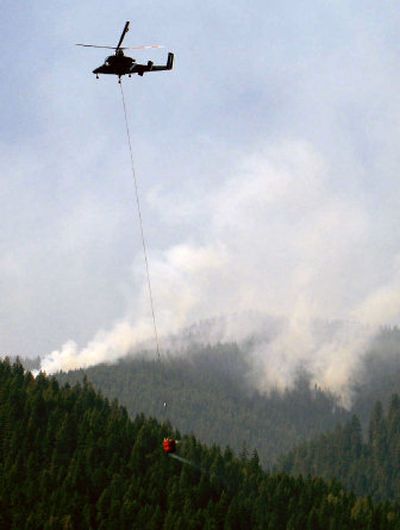Wind fears spark concern

Dry winds are expected to whip through the Inland Northwest today and tonight.
Strong gusts are nothing new for the Inland Northwest, but the incoming weather system and the current scarcity of firefighting resources is prompting comparisons with the conditions that led to massive fires in 1910.
“The key here is to get through the next two days. Those are going to be pivotal days for us in terms of fire behavior,” Idaho Panhandle National Forests spokeswoman Gail West said Monday afternoon.
The fires in 1910 were started when gale-force winds caused hundreds of small fires in North Idaho and Montana to merge into a massive blaze that burned 3 million acres, killed at least 85 people and burned entire towns.
Today, fewer than 10 fires are burning in these same forests of North Idaho, but West said the historic blaze is being increasingly discussed among firefighting officials, especially when high winds are predicted.
“I’ve heard a lot of comparisons from the 1910 situation compared to this year,” she said.
Fires across the Inland Northwest grew substantially Monday and little progress was reported in containing the blazes. An exception was a fire that burned 3,500 acres near Colfax. The fire was declared 100 percent contained Sunday.
Massive fires near Dayton and in remote north-central Washington continue to grow. The fires near Dayton were estimated to have burned 64,000 acres and are only 20 percent contained. The fires in north central Washington have burned more than 140,000 acres and are not expected to be contained until Oct. 1, according to estimates posted by firefighters at www.inciweb.org.
The fires in North Idaho remain relatively small, but most are burning in terrain inaccessible by road. Without direct backup support from aircraft – there’s barely a firefighting plane or helicopter to spare nationwide – managers are reluctant to have firefighters hike into these remote areas.
One such fire is burning in the upper reaches of Long Canyon, a roadless valley located north of Bonners Ferry, Idaho. The fire was sparked by lightning earlier this month, but has grown to about 50 acres in the past week thanks to recent dry, hot conditions, said Pat Behrens, acting district ranger for the U.S. Forest Service. A helicopter spent a portion of a day last week dumping water on the fire, but was called away to help fight fires that posed more immediate threats.
“Since then, we haven’t had the resources to do anything,” Behrens said.
The Long Canyon Fire is too remote for gear-laden firefighters to reach on foot and not enough helicopters or planes are available to support ground crews, Behrens added. “We didn’t feel like we could get people in there safely. Our number one consideration is going to be – no matter what – firefighter safety.”
The fire is being watched closely, Behrens added. Each morning a small airplane flies over the entire region gathering fresh information on all the fires. The supervisor of the Panhandle National Forests is also in frequent communication with fire managers across North Idaho to help marshal the scarce resources.
Firefighters are also largely unable to reach fires burning northwest of Priest Lake and along the Montana-Idaho border. The Hughes 32 Complex of fires northwest of Priest Lake has burned 1,300 acres as of 7 p.m. Monday. A fire on Ulm Peak, on the Montana-Idaho border about 12 miles southwest of Noxon, Mont., has burned about 1,200 acres. Both are estimated at 5 percent or less containment.
More firefighters and aircraft could be coming soon from the Southwest, where the fire season is coming to an end, said West. “Multiple times a day we’re sizing up these fires and seeing what resources become available.”
For now, the main worry is the weather, West said.
Winds up to 30 mph are expected to blow through today and tonight, according to a warning issued by the National Weather Service.
There’s a 20 percent chance of rain showers Wednesday, but the hot, dry weather is expected to return by week’s end.